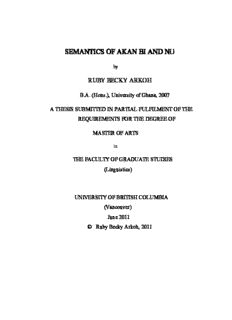Table Of ContentSEMANTICS OF AKAN BI AND NƱ
by
RUBY BECKY ARKOH
B.A. (Hons.), University of Ghana, 2007
A THESIS SUBMITTED IN PARTIAL FULFILMENT OF THE
REQUIREMENTS FOR THE DEGREE OF
MASTER OF ARTS
in
THE FACULTY OF GRADUATE STUDIES
(Linguistics)
UNIVERSITY OF BRITISH COLUMBIA
(Vancouver)
June 2011
© Ruby Becky Arkoh, 2011
Abstract
This thesis investigates two post-nominal morphemes, bi and nʊ, in Akan (a Kwa language spoken
mainly in Ghana). I analyze bi as an indefinite marker and nʊ as a definite marker.
Bi occurs in different environments; the main two environments are the pronominal environment and
the determiner environment where it follows the noun within a DP. These environments correlate with
certain tonal variations. I argue that in the pronominal use, bi is a specific indefinite pronoun and is
toneless. Its specificity status is achieved through a weak anaphoric relationship it shares with a
previously-mentioned noun in the discourse or a deictic element. In its determiner use, bi is a specific
indefinite which is interpreted via a choice function. It bears a high tone.
The Akan morpheme nʊ is used for different functions. It is used as a third person singular pronoun, as
a definite article, as a distal demonstrative marker and as a clausal marker. These uses correlate with
some tonal alternations. I argue that when the morpheme is used as a pronoun, it is toneless; however
when it is used as a determiner or a clause marker it is marked with a high tone. I also argue that the
morpheme in all its different functions encodes one semantic value which is familiarity. I take
familiarity to entail both hearer old and discourse old along the lines of Prince (1988).
ii
Preface
The name of the UBC Research board for the ethic certificate is Behavioral Research Ethics
Board. The following is the numbers for the ethic certificate obtained:
Date of Approval: Certificate Number:
July 11, 2007 H07-01365
June 9, 2008 H07-01365
May 22, 2009 H07-01365
May 4, 2010 H07-01365
May 6, 2011 H07-01365
iii
Table of Contents
Abstract ............................................................................................................................................... ii
Preface ................................................................................................................................................ iii
Table of Contents ................................................................................................................................ iv
List of Tables ..................................................................................................................................... vii
List of Figures ................................................................................................................................... viii
List of Abbreviations .......................................................................................................................... ix
Acknowledgements ............................................................................................................................ xi
Dedication ........................................................................................................................................ xiii
1 Introduction.................................................................................................................................. 1
1.1 Akan .............................................................................................................................................. 1
1.1.1 Sound inventory of Akan ..................................................................................................... 2
1.1.2 Plural marking in Akan ........................................................................................................ 4
1.1.3 Word order in Akan ............................................................................................................. 4
1.2 Methodology................................................................................................................................. 4
1.3 Organization of the thesis ............................................................................................................ 5
2 Internal structure of the Akan DP ................................................................................................. 6
2.1 Introduction .................................................................................................................................. 6
2.2 The basic phrase structure in the language ................................................................................. 6
2.3 The phrase structure for the nominal items in Akan .................................................................. 7
2.4 Conclusion .................................................................................................................................. 11
3 Semantics of the Akan bi ............................................................................................................ 12
3.1 Literature review ........................................................................................................................ 13
3.2 The two-way mechanism of marking indefiniteness in Akan................................................... 15
3.3 The two environments of bi ....................................................................................................... 17
3.4 Tonal alternations of the morpheme bi ...................................................................................... 19
iv
3.4.1 Tonal realization of the indefinite pronominal bi .............................................................. 20
3.4.2 Tonal realization of the indefinite determiner bí ............................................................... 21
3.5 The specificity of bi .................................................................................................................... 23
3.5.1 Bi as a specific indefinite pronominal marker ................................................................... 23
3.5.1.1 Bi and one/some-anaphora ................................................................................................ 25
3.5.1.2 Specificity in Enç’s sense .................................................................................................. 29
3.5.2 The determiner bí ............................................................................................................... 33
3.5.2.1 Fodor and Sag’s sense of referentiality ......................................................................... 33
3.5.3 Bí as referential .................................................................................................................. 34
3.5.4 The scope of bí ................................................................................................................... 39
3.5.4.1 Bí and bare nouns .............................................................................................................. 40
3.5.4.2 Bí and kàkrá ‘few’ ............................................................................................................. 40
3.5.4.3 Bí and nyìnáá ‘all’ ............................................................................................................. 41
3.5.4.4 Bí and bíárá ‘every’ ........................................................................................................... 42
3.5.4.5 Bí does not allow intermediate scope with nyìnárá ‘all’ and kàkrá ‘few’ ....................... 49
3.6 Conclusion .................................................................................................................................. 50
4 Semantics of Akan nʊ ................................................................................................................. 51
4.1 Introduction ............................................................................................................................ 51
4.2 Literature review ........................................................................................................................ 52
4.2.1 Marking of definiteness in Akan ........................................................................................ 52
4.2.2 Amfo’s analysis of nʊ ...................................................................................................... 53
4.3 Tonal alternations for the morpheme nʊ ................................................................................... 56
4.3.1 Tonal realization of the pronominal nʊ .............................................................................. 56
4.3.2 Tonal realisation of the determiner nʊ .............................................................................. 58
4.4 Nʊ as a pronominal .................................................................................................................... 60
4.4.1 Akan pronouns ................................................................................................................... 60
4.4.2 Familiarity of the pronominal nʊ ....................................................................................... 64
v
4.5 Nʊ́ as a determiner ..................................................................................................................... 68
4.5.1 Nʊ́ as a definite marker ...................................................................................................... 68
4.5.2 Definiteness: uniqueness or familiarity? ........................................................................... 68
4.5.3 Nʊ́ is obligatorily familiar .................................................................................................. 69
4.5.4 Akan definite nʊ́ is equivalent to a strong definite ........................................................... 72
4.5.4.1 Weak article definites ........................................................................................................ 72
4.5.4.2 Strong article definites ...................................................................................................... 76
4.5.4.3 Bridging ............................................................................................................................. 79
4.6 Nʊ́ as a distal demonstrative ...................................................................................................... 83
4.6.1 Demonstratives in Akan ..................................................................................................... 83
4.6.2 Dɛ́m is not necessarily familiar .......................................................................................... 84
4.6.3 Dɛ́m makes the NP salient ................................................................................................. 87
4.6.4 Conclusion .......................................................................................................................... 89
4.7 Nʊ́ as a dependent clause marker .............................................................................................. 89
4.8 Conclusion .................................................................................................................................. 91
5 Conclusion ................................................................................................................................. 92
References ......................................................................................................................................... 95
vi
List of Tables
1 Consonant inventory ................................................................................................................. 3
2 Full paradigm of Akan pronouns ........................................................................................... 59
vii
List of Figures
1 Vowel inventory ........................................................................................................................ 2
viii
List of Abbreviations
Acc Accusative
Adj Adjective
Ak Akuapem
Ani Animate
ATR Advanced Tongue Root
As Asante
CH Choice Function
CM Clause Marker
Comp Complementizer
CP Complementizer Phrase
Dat Dative
DCM Dependent Clause Marker
Dem Demonstrative
DP Determiner Phrase
e Empty Category
f Function
Fa Fante
Fam Familiar Marker
Foc Focus Marker
Fut Future Marker
H High Tone
ix
Inani Inanimate
L Low Tone
N Noun
Num Numeral
Obj Object
Past Past Tense Marker
Perf Perfective Marker
Pl Plural
PP Prepositional Phrase
Poss Possessive Marker
Prog Progressive Aspect Marker
QP Question Particle
Ref Referential Marker
Rel Relative Clause Marker
Sg Singular
Spec Specificity Marker
Subj Subject
SVO Subject-Verb-Object Order
VP Verb Phrase
x
Description:This thesis investigates two post-nominal morphemes, bi and nʊ, in Akan (a Kwa language spoken 'Who is it that Kofi will meet tomorrow?'.

